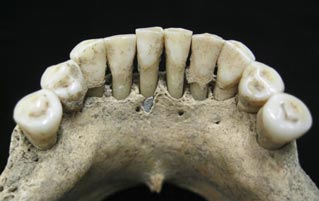How A Dead Nun Ended Up With Teeth Full Of Treasure

In 2014, archaeologists excavating a 12th-century graveyard in Dalheim, Germany unearthed something unusual: the skeleton of a nun whose dental tartar was embedded with flecks of lapis lazuli -- a mineral that in those days was one of the rarest (and therefore most priceless) things on the planet.
In the same way the color purple was once associated with royalty because purple dye was exceedingly hard to mass-produce, lapis lazuli could only be found in a single region of Afghanistan. The long journey that the mineral had to take to Europe meant that, pound for pound, it was more expensive than gold. Which immediately made it a mainstay amongst artists of the era, not least because using it in paintings was a clear sign they (or their clients) were wealthy as hell.
So how did antiquity's most precious mineral wind up in the mouth of a nun? When archaeologists took a look at how the lapis lazuli was distributed inside her mouth, they soon figured out that they weren't looking at a onetime thing. It gradually had built up over a span of time, which hinted at only one possible explanation.
Remember how we said that lapis was a popular pigment amongst the artists of the day? Alongside grandiose paintings, it was also used to decorate religious manuscripts -- a role which fell to nuns, on account of how "activities related to book production were considered worthy pursuits." As for how specifically the lapis was introduced to her teeth, that's because, well ...
In adding detail to their illuminations, it is plausible to assume that artists would have occasionally licked their brushes to make a fine point, a practice that later artist manuals refer to explicitly. In doing so, pigments, such as lapis lazuli, may have been introduced into the oral cavity, where they could have become entrapped within dental calculus. The repeated activity of inserting the tip of the brush into the mouth could explain the distribution pattern.
The archaeologists do hedge their bets by suggesting several other scenarios ("it is possible that the lapis lazuli ... entered the oral cavity through the kissing of painted images"), but that's probably because they wanted to negate some of the embarrassment at having stumbled across Ralph Wiggum's medieval ancestor.
Adam Wears is on Twitter and Facebook, and has a newsletter dedicated to depressing history facts. It's not as heartbreakingly sad as it sounds, promise!
If you loved this article and want more content like this, consider a visit to our Contribution Page. Please and thank you.
For more, check out According To Marvel, Loki Wasn't Really A Villain ... Huh? and Check It Out, Nerds: There's A 'Ghostbusters' Dinosaur.
Also, we'd love to know more about you and your interesting lives, dear readers. If you spend your days doing cool stuff, drop us a line at iDoCoolStuff at Cracked dot com, and maybe we can share your story with the entire internet.
Follow us on Facebook. If you like jokes and stuff.